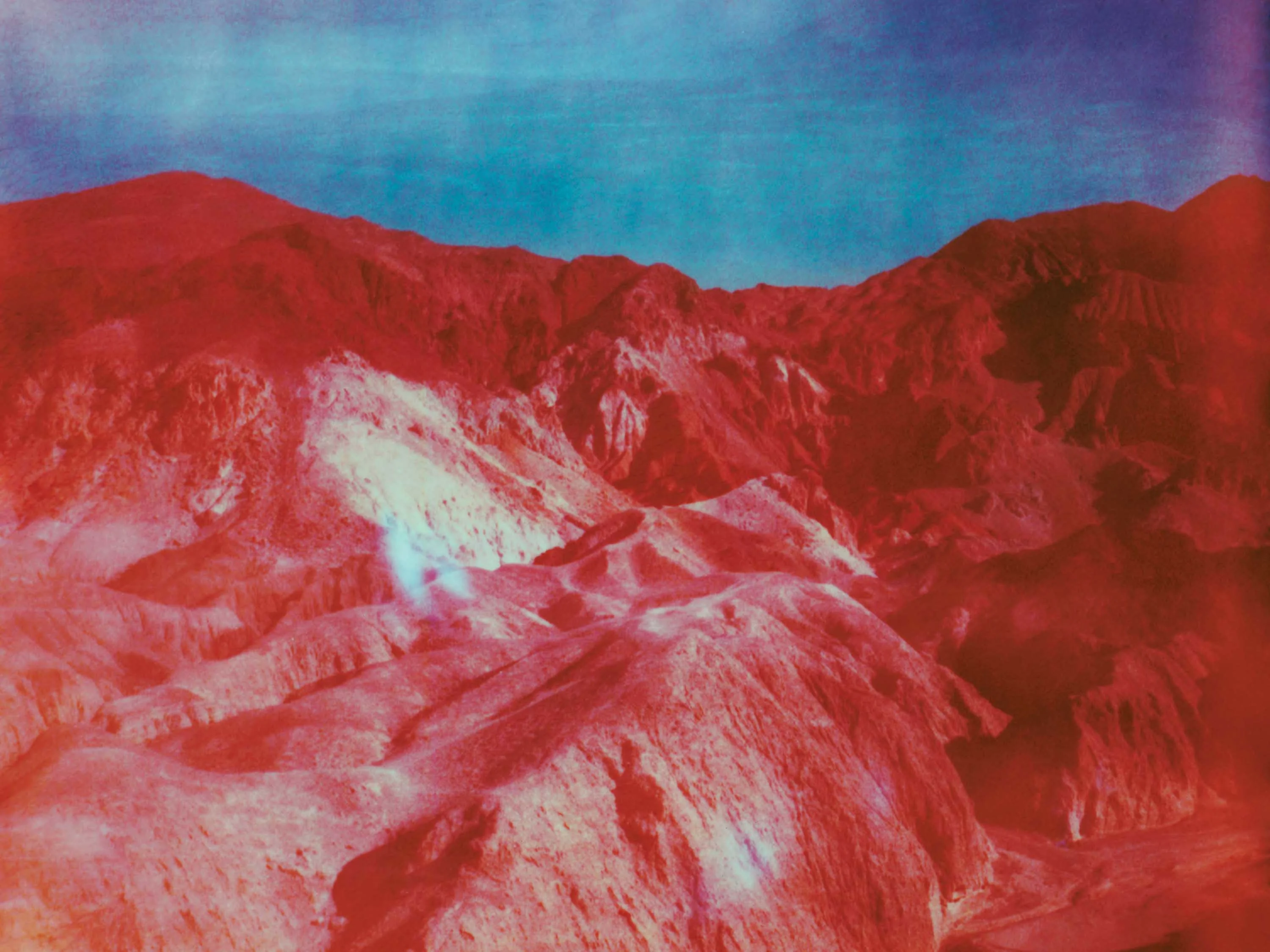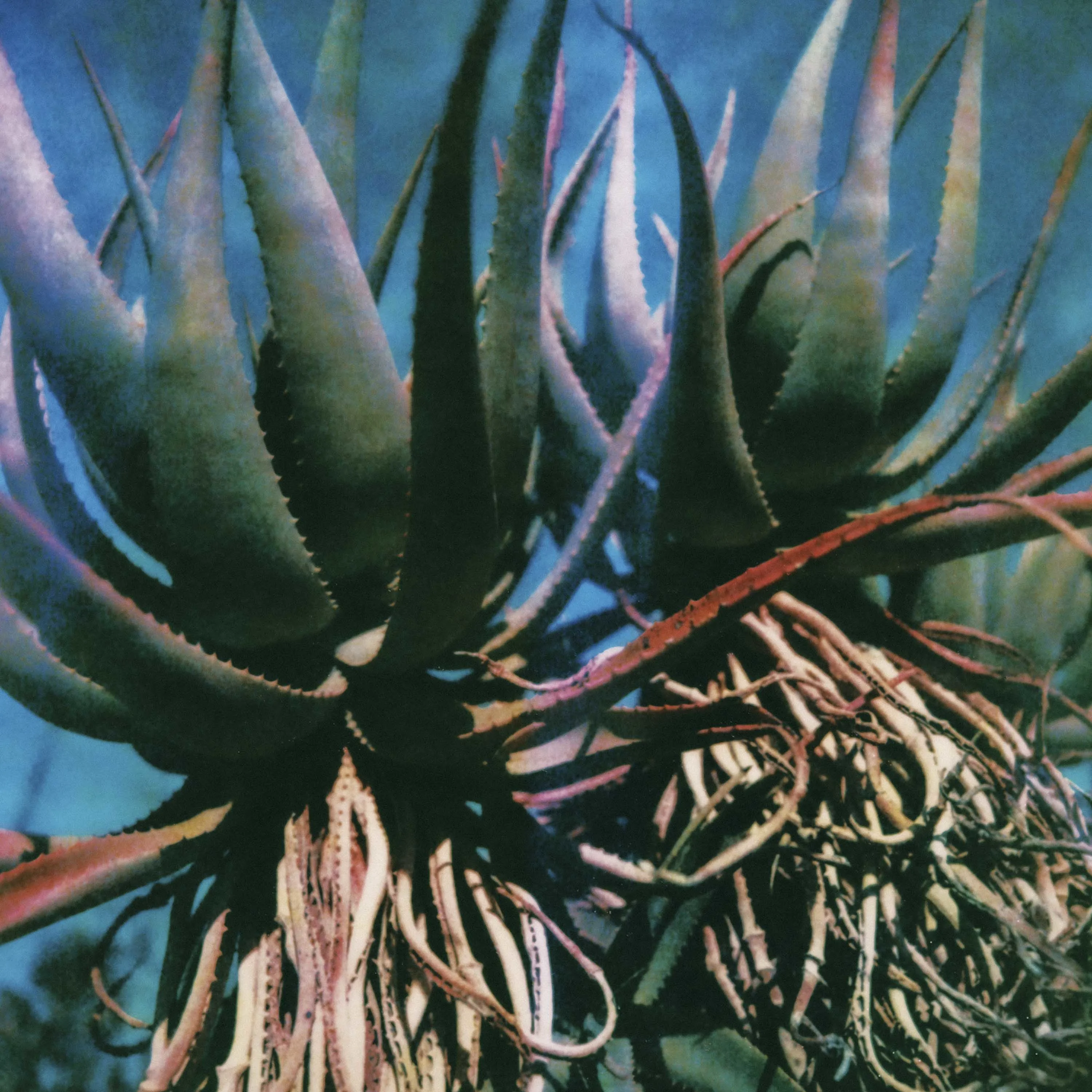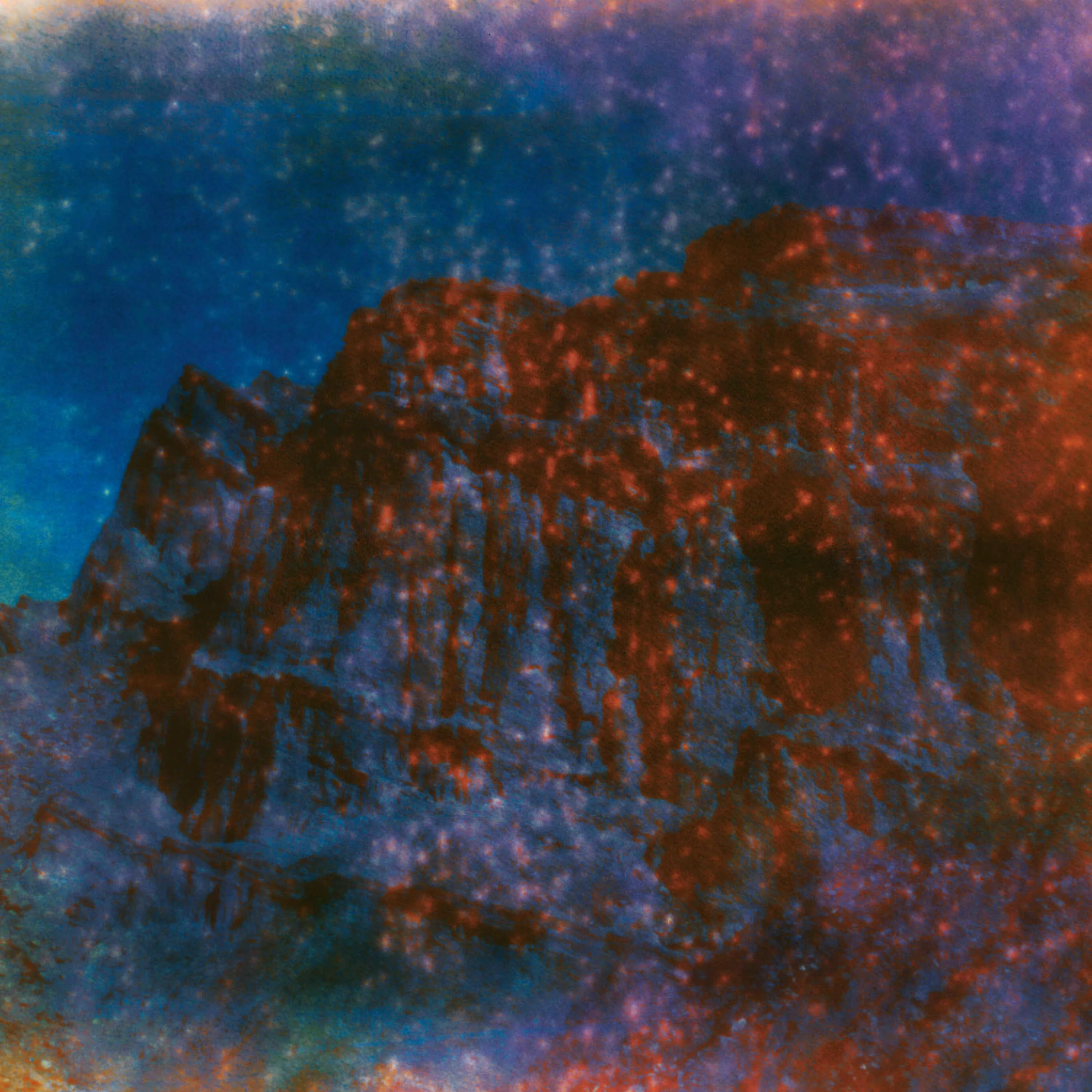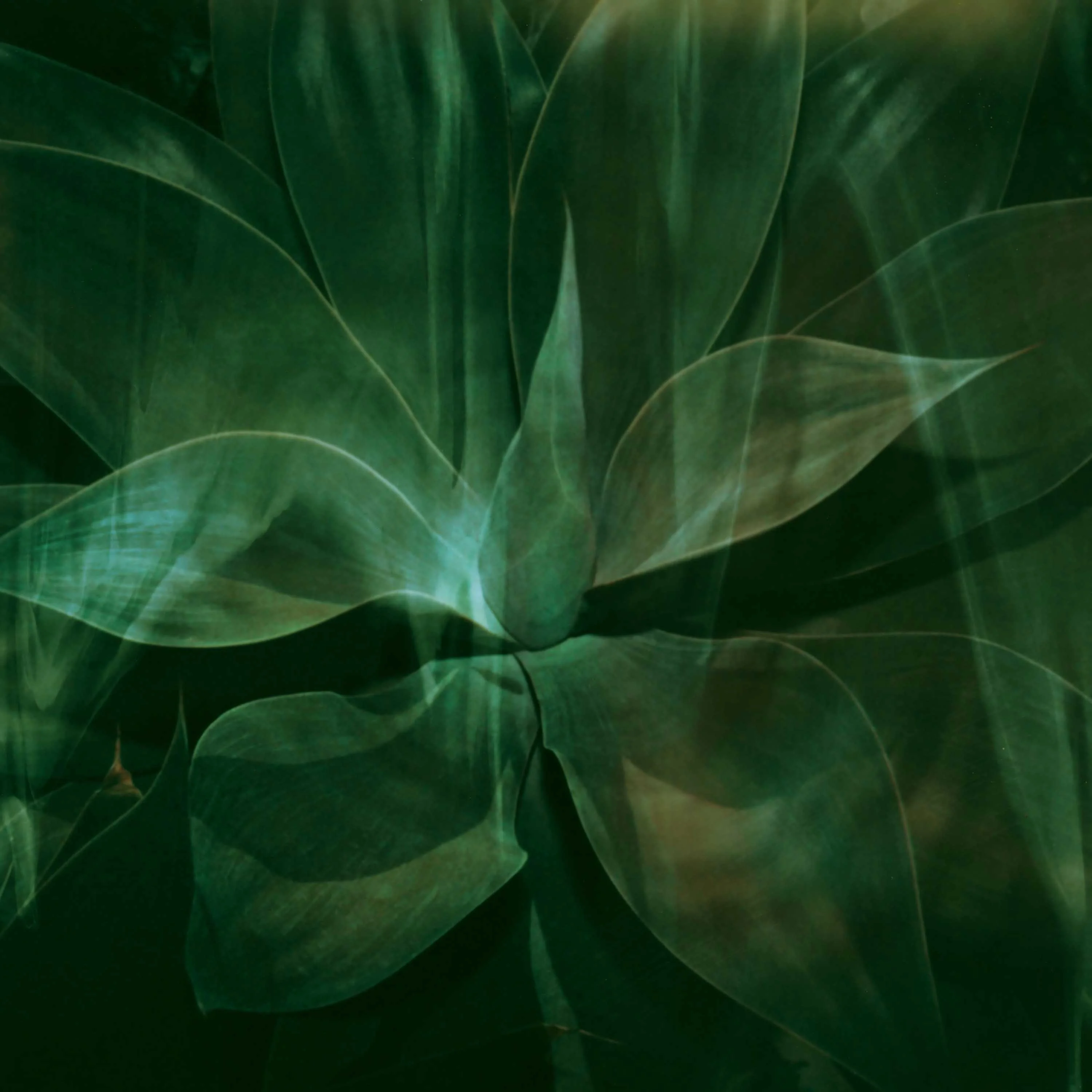
Deserts are spaces of quiet desolation and vast emptiness. But for musicians, that very blankness can catalyze creativity, freeing them of outside influences and forcing them to look inward for inspiration. Writer Jenn Pelly spoke to artists who have put down roots in the deserts of the world – including Tinariwen guitarist and songwriter Abdallah Ag Alhousseyni and musician Cate Le Bon – to find out how the landscape has shaped their sound and altered their perspective.
Photos by Neil Krug.
The show had no address. The street number wasn’t simply unannounced: There was no street. To get to the gig, you could only follow coordinates.
Where better to place an unplaceable sound? At 33.6757, -115.8106, we knew the clatter of our set would incorporate rocks from the ground. It was April 2019, and our performance project was playing the grassroots Joshua Tree Zine Fest in the Mojave Desert alongside a handful of other DIY bands. If self-consciousness is the death of art, then the desert’s remoteness facilitated the opposite. The alien landscape seemed to beckon us further out.
For generations, the desert’s sandy expanses have pulled in musicians with the promise of solitude and inspiration in stillness and space. The burnt sprawl, glowing cacti, unruly tumbleweeds and wildflowers have provided a unique alchemy to such seekers, dissolving the noises of the world that so often lead to doubts. From the Mojave, Sonoran and Chihuahuan deserts of North America, to the vast African Sahara and Australian outback, artists have always been drawn to the possibilities of tuning out the world in order to tune into themselves.
“There’s so much space,” said Robyn Celia, who owned the desert venue Pappy & Harriet’s in Pioneertown, California from 2003 to 2021. “If you’re in the right place, you can hear the blood in your veins.

Many musicians cite the desert as a place to hone and deepen their personal voice. And yet, whether in the incandescent alt-rock of “Meat Puppets II,” or in the scorched, exalted tone of Tuareg guitarist Mdou Moctar, you know a desert record when you hear one. It’s in the driving rhythms and skylike structures; in the warm, dry tone; in the air of psychedelia, with entrancing repetition at its heart. Joni Mitchell made her cracked-open 1976 jazz fusion opus “Hejira” under the spell of the desert, singing of coyotes and endless skies and the burning ground. “I suppose a lot of people could have written a lot of my other songs,” Mitchell once said, “but I feel the songs on ‘Hejira’ could only have come from me.”
That virtue of idiosyncracy is widely echoed by seasoned desert artists. The late sculptor Noah Purifoy, famous for his outdoor museum in Joshua Tree, once referred to the process of creativity as an act of self-interrogation. “Art as an escape from the world, that’s wrong,” he explained. “But escape is what most people want. Art should be a confrontation with a ‘me’ that is always in need of improving.” At the coordinates of the desert’s silence and space lies that profound confrontation.
The deserts are boundless crosshairs. In the 2015 documentary Lo Desert Sound, about Joshua Tree low-desert alt-rock of the 1990s, musician Mario Lalli described the backdrop of that famed scene: “It was on the edge of infinity.”

Seven thousand miles east of Joshua Tree, in the Saharan deserts of Niger, the guitarist Mdou Moctar is among the latest artists representing the desert blues of the nomadic Tuareg people, who have roamed the Sahara for thousands of years, herding cattle along the Niger River. (Today, they’ve settled in Niger, Mali, and beyond.) Moctar’s musical tradition extends back to his predecessors, like the late Malian guitarist-singer Ali Farka Touré and the desert blues band Tinariwen, which began playing in Tuareg refugee camps in 1979 and continues to tour internationally. (Moctar covered Tinariwen’s song “Chet Boghassa” on his live album “Afelan”in 2013.) The roots of Saharan desert blues can also be traced through centuries of Tuareg folk music, such as that documented on the 1960 Folkways Records compilation “Tuareg Music of the Southern Sahara.”
With electrified rock’n’roll, Tinariwen, Moctar, and others, like Les Filles de Illighadad and Bombino, are carrying the loping, hypnotic repetition and ecstatic verve of Tuareg music into the future. Moctar’s acclaimed 2021 album “Afrique Victim” has propelled his status, while his song “Tala Tannam” was included on a best-of-the-year list by Barack Obama.
After Moctar debuted in 2008, his music quickly caught on through the Sahel region’s favored DIY music network: MP3s shared from cellphone to cellphone via Bluetooth and memory cards. It was through this network that, in 2009, that some of Moctar’s recordings first landed upon the ears of an American traveler named Christopher Kirkley, who made it his mission to track the guitarist down. Kirkley ultimately released three Moctar albums on his blog-turned-label, Sahel Sounds, which has become a groundbreaking outpost for West African desert music since its launch in 2010. He has since released albums by the likes of Les Filles de Illighadad—whose leader, Fatou Seidi Ghali, has been acknowledged as the first professional woman Tuareg guitarist—and Hama, an electronic musician from Niger.
The region that birthed Moctar remains musically vibrant (“Everyone listens,” Fatimata Ahmadelher of Les Filles de Illighadad told The Guardian. “Everybody plays”) even as it continues to suffer the lasting impacts of French colonialism, which Moctar explored in a New York Times op-ed last year. Moctar described how deficiencies in electricity have left him unable to power an amplifier at home. The shoddy internet makes it hard for musicians to distribute their own works online independently.

Yet many West African musical talents still develop and emerge in the desert because playing music live is a viable job, even in the absence of traditional venues. Young people can make good money playing live at weddings, which are their primary concerts. “Weddings are our festivals,” said the frontman of Algerian desert rock quintet Imarhan, who goes by Sadam. “They are also our spring boards for young artists to make a name for ourselves.”
Imarhan formed in 2006, and the band’s music reflects the elements of the desert: sand, sun, space, stillness. “And wind,” Sadam added. “Our sound is full of this energy. It’s our nature and in our blood.” This is reflected most deeply on their new album, “Aboogi,” recorded at a studio the band built in the desert. It’s the first recording studio built in their hometown of Tamanrasset—the first studio in the whole region, according to Sadam, who is the cousin of Tinariwen bassist Eyadou Ag Leche and has also toured as a member of the elder group.
“It was built with only local materials, by us and our friends in Tam,” Sadam explained of the studio. “The whole building is from Tam, and gives this special color to our sound. Its shape is round; it looks like the first houses the nomads used to build back in the days of their first settlements. We wanted to pay tribute to our community in giving echo to those traditions.”
Like Tinariwen before them, Imarhan ties its sound to the feeling of assouf, or spiritual pain and homesickness, describing it as a singularly desert feeling. “Assouf is our nostalgia, our blues,” Sadam said. “In the nostalgia there is hope because you would always hope to find again what you miss. The space in the desert gives a lot of room for nostalgia. The wind specifically is an element that brings nostalgia. It makes you travel in your mind. You will feel carried by the wind, even if you are surrounded by people.” The wind, Sadam said, will carry you back.



In late August, Mdou Moctar and his band played the biker bar-turned-rock venue Pappy & Harriet’s on the edge of the Mojave desert, as Tinariwen did before them. Surrounding that gig, Tinariwen also spent time recording its 2014 album, “Emmaar,” in Joshua Tree at the home studio Rancho de la Luna. During a video interview from Paris, Tinariwen guitarist and songwriter Abdallah Ag Alhousseyni said through a translator that the group felt at home in Joshua Tree. Alhousseyni is one of four singer-songwriters in Tinariwen, each of whom, he said, is influenced by the desert in their own ways. The band name means “deserts,” plural, underscoring the various regions through which the Tuareg have wandered: Mali, Algeria, Libya, Niger—“All different areas of the Sahara that are part of their identity,” he said. “All deserts, but not exactly similar. Tinariwen is the sum of all of those places.” When Abdallah stares out onto the flat, infinite landscape, the horizon remains an eternal fount of poetry.
“You end up creating music that’s more yourself,” said California acid folk musician Kayla Cohen. Until recently, Cohen lived in Yucca Valley, where she wrote her upcoming album under the moniker Itasca. Her poised songwriting conveys the stillness of the desert, and “the dryness of the plants,” she said with a light laugh. In the desert, Cohen said she can access the mental space to focus more deeply on honing her voice, digging into her influences while avoiding too much outside interference, and focusing on long, intricate guitar pieces. While working on her upcoming record, she found that, in the space and quiet, she gravitated towards the heavy metal of Judas Priest, Paul Chain, Dark Quarterer, and Diamond Head. “Their guitar style is what I was most influenced by,” she said. “It’s kind of medieval.”
Feeling literally burnt by the desert, though, Cohen returned to Los Angeles earlier this year. “I just couldn’t take it anymore—I felt like I was going to die like any other desert creature, all dried out,” Cohen said. “I’m pretty adaptable, but no matter how much air conditioning you have in your house, it’s hard to live out there.” She felt the influx of newcomers during the COVID-19 pandemic made the small town feel more crowded. New residents started putting up fences.

During her days in Joshua Tree, Cohen reflected, the persistent sun often commanded a time-stopping power. “There’s this thing that happens everyday around 3 or 4 p.m., if you’ve been up all day and you don’t have all that much to do,” she said. “I start thinking of it as staring into the void, or confronting death everyday. It’s this crazy feeling: What am I doing? What did I just do with my day? There’s no people around. It’s kind of existential, and can be really heavy. You can’t explain it unless you’re there.”
She wrote her previous record, 2019’s “Spring,” in the New Mexico desert, each carefully calibrated note glistening with the overwhelming feeling of catching the piercing sun in your eye. Though the environment is markedly different from California—particularly in the plantlife and the awareness of history—a similarly infinitesimal feeling crept in. “You have the vibe that you are inconsequential in the face of the passing of time,” she said. “That can be good.”

The Welsh musician Cate Le Bon first visited the Joshua Tree desert in 2013, shortly after she moved to LA. “I had no real idea what it might look or feel like,” she said, “just an abstract vision of a desert and Gram Parsons’ ghost.” (In 1973, the beloved country rocker overdosed on morphine and alcohol at the Joshua Tree Inn; and was pronounced dead at the High Desert Memorial Hospital in nearby Yucca Valley. Today, Room 8 at the Joshua Tree Inn is named for Parsons, and according to the hotel’s website, “some say his spirit still lives.”)
Le Bon was driving to Joshua Tree in her 1981 Honda Accord to meet visiting friends when the car’s tires exploded on the freeway. She rolled into the desert later in the day than expected. After zooming past “all the American racket” of Carl’s Jr. and Starbucks, “it changed in a blur to land filled with Joshua trees… uninterrupted as far as the eye can see. The light and everything it touched had a creamy pink hue. I had never seen light like that before.”
The image still leaves her speechless. “The calendar ceases to exist,” she said, “and everything hangs in the air.”
Growing up in Wales, with its own remote beauty, she was “immediately drawn to” the landscape, and finally moved to the desert in 2021. “I have always felt at ease in landscapes where I can willingly get lost, but this was like being inside a child’s imagination of what another planet might look like,” she said. Like the unusual plant life springing from the dry ground, Le Bon’s baroque pop, particularly 2019’s “Reward,” can evoke feelings of uncanny emergence and delight in the stark unknown.

“Even now, when I wake up there, I immediately go to the window to check if the landscape is real and hasn’t disappeared overnight,” Le Bon said. “I make a coffee and walk to the Joshua tree that’s over 400 years old and sit under it and have a think.” Time can seem to cease to exist beyond the distinction of light and dark, collapsing or expanding moments. “Sometimes it’s morning coffee and then it’s dinner time. Sometimes morning lasts all day. Within that I can get lost even in the familiarity of a home.” Such repetition is properly psychedelic.
When the sun is close to setting, she likes to leave the house without her phone to walk or run around the sandy roads, absorbing it all—the “performance and gravitas of the cacti,” the Joshua trees, the mountains. “I really don’t take any of it for granted,” she says. “It all fills me with an awareness that I’m only passing through and I’m trying to hold it all in my gaze for as long as I can. The space and suspension allows me to feel invisible and inconsequential, which is when I’m able to tap into the childlike free feeling and make things completely uninhibited,” she said.
“I don’t really have a process when it comes to writing, but there are a set of conditions that lure me into a place where I feel a lightness that carries me, and the desert is a lullaby.”